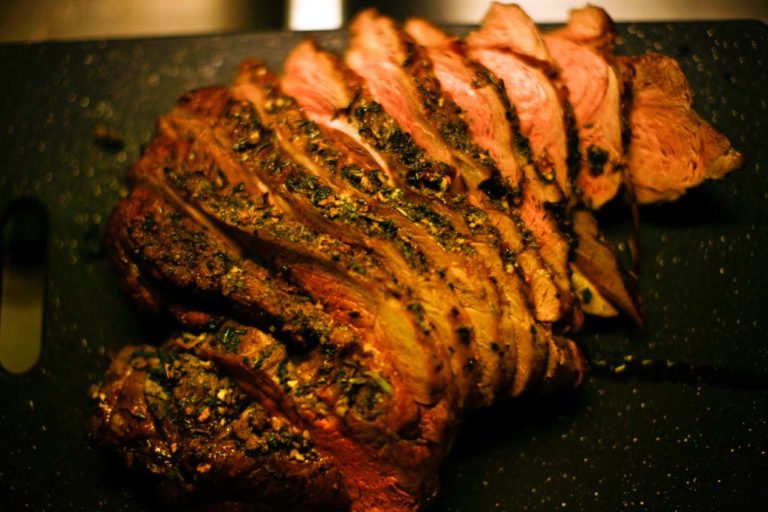
Chef's notes:
The first time I ate lamb, it was sliced thinly with pork in a sauce of tomato, onion, and rosemary. The flavor was not one of my favorites, and I picked through it to get mostly pork in my pita. Looking back now I realized the lamb was overcooked, but that was not the reason I didn’t like it—the flavor was just too strong for me. Even though I was raised on intermittent venison meals, I didn’t like the lamb. But, to be fair, I never was very fond of venison when I was young either.
These days, after cooking it and eating it hundreds of times, I love lamb. But not many Americans do, as less than 1/2 a pound is consumed per person annually. Here is a little perspective on that statistic: we eat 60 pounds of beef per person annually. So, why do we eat beef 120 times more than we eat lamb? Well, it could have something to do with the west being built on the back of steer. Or is it simply that Americans prefer the taste of beef?
Ingredients
- 1 boneless leg-of-lamb
- Sea salt
- Black pepper
- ½ cup chopped fresh mint
- 1 sprig chopped fresh rosemary
- 6 minced garlic cloves
Roast Lamb Recipe: Whole Boneless Leg of Lamb Roasted with Sea Salt, Black Pepper, Mint, Rosemary and Garlic
- Leg of lamb. First, start heating up the oven to 500 degrees F. This will take at least 30 minutes. Leg of lamb comes either on the bone or boneless. Cooking it on the bone adds a lot of flavor and moisture, but it takes a little longer. I used a boneless leg of lamb for this article, as it’s just easier. Remove the net the roast comes in so you can open up the meat and flavor it. The boneless lamb will lay pretty flat when you unroll it. Make crisscross incisions across the fatty side of the roast, and be careful not to cut too deep. Some classic herbs and flavorings for lamb include mint, rosemary, and garlic. Chop them finely and rub it all over the meat. Don’t forget about the salt and pepper.
- Roast the lamb. Once you have finished applying your spices and herbs, roll the meat back up like the way it came. You can tie it shut using butcher’s twine if you want. I didn’t. Place the roast in a roasting pan. I line mine with aluminum foil for easy clean up. When the oven is finished preheating, put the lamb in the oven on the rack just above the bottom position. Shut the door quickly and set the timer for 30 minutes. This first stage of roasting is converting the fat into a tasty, crunchy treat.
- Low Heat Finish. After 30 minutes have passed, take the roast out of the oven and check the temperature. Since most leg of lamb roasts are the same size, I am guessing it should read around 110 degrees F, as long as you put the digital thermometer in the center of the thick spot. Lower the temperature of the oven to 200 degrees F, and let the oven cool down a little by leaving the door open a crack for a short time. This last stage of roasting is going to slowly bring up the middle temperature to 140 degrees F. Once the oven is a little cooler, put the roast back in, close the door, and set a timer for 45 minutes.
- Rest the Lamb. Using time as a guide is not a very effective way to cook, as time alone does not cook meat—heat is required. With this in mind, using a digital thermometer with a detachable probe to monitor the internal temperature of the roast as it rises is the best way to make sure it is properly cooked. Once your desired internal temp is reached—130 for rare, 140 medium rare, 150 medium, 160 burnt—take the roast out of the oven and cover it with aluminum foil. Let the it rest for 20 minutes. Slice thinly, and enjoy!
Tips & Tricks
- Another way to roast lamb is to start it at 350 degrees and roast it until it is close to being done and then crank the oven to 500 to get the outside crusty. This technique is much faster, but it may be too fast and doesn’t leave much time for the flavorings to sink in. You could start at 200 degrees, and once it is 20 degrees below desired temperature, finish it at 500 degrees. That would work alright.
- Don’t open the oven unless you have to. Letting all the heat out is bad.
- Elevate the meat while it rests, so the juices have somewhere to go. I elevate one side of the pan so the juices all run to the other. Or you can put it on a rack.
- Some butchers require advanced notice for some cuts of meat, but usually no more than a day.
- Some butchers require advanced notice for some cuts of meat, but usually no more than a day.
